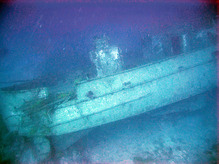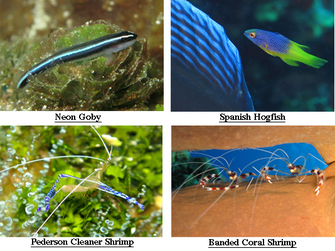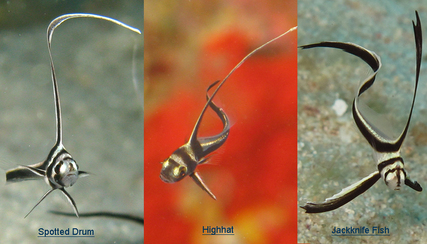 Jellyfish have been around for over 650 million years, long before the time of the dinosaurs. They are about 95% water and have a very simple nervous system, used for detecting light, orientation and salinity. They can actively hunt plankton and small pelagic fishes, using stinging cells on their tentacles called nematocysts. The prey is pulled into the body for digestion. Some fish have adapted to live among these tentacles without getting stung. Jellyfishes from Caribbean Reef Life on Vimeo.  The sting of some jellyfish can be quite painful to divers. Do not rub the area or apply fresh water, this will only cause more nematocysts to activate. Hot water or vinegar will neutralize some of the sting. The Thimble Jelly can gather in groups of millions of individuals. This is called a bloom, and usually occurs in late summer when nutrient levels in the ocean are high. The blooms can become so dense as to blot out the sun!
0 Comments
Spotted Eagle Rays from Caribbean Reef Life on Vimeo.  Eagle Rays have their mouths under their bodies for digging into the sand, where they find their food, such as molluscs and other invertebrates. They sense prey by using electroreceptors similar to those of sharks. They are also fast enough to catch and eat smaller fish, and have even been seen to jump clear out of the water, as they hunt near the surface. Their skeletons are made of cartilage, except for two bony plates in their mouths for crushing their food.  Eagle Rays look very different from below and above. This helps them to move about without being noticed by their main predators, the sharks. The white belly makes them hard to spot from below, looking up toward the light. The pattern of spots on their backs breaks up their outline when seen from above. They can sometimes be found swimming in groups of two or more as they move between favorite feeding grounds.  Eels have evolved a very flexible and elongated body shape that allows them access to more food sources than other fishes: animals that are hiding deep within crevices of the reef. Some can even swim under the sand. To help with this, they have no pectoral fins or lobed tails. Instead, they have a single, long, dorsal fin running the length of their bodies. As they swim, they will twist their bodies 90 degrees and undulate to move them forward. Green Moray from Caribbean Reef Life on Vimeo.  Eels are carnivores, and mostly hunt at night. They have large extended nostrils and a very keen sense of smell to help them find their food in the darkness. Green Morays have a series of backward facing teeth on the roofs of their mouths to help keep prey from escaping. Eels are beginning to hunt lionfish on their own, but now the practice of feeding lionfish to them is discouraged, as the eels are following groups of divers, and even molesting them, instead of hunting for themselves.  The Josie J: This cargo ship ran the regular run between the mainland of Honduras and French Harbour, until the day mechanical failure in the ship's pumps caused it to start listing heavily to port on it's homeward journey. It was towed in, until a larger ship from French Harbour arrived, tied up alongside and tried to pump the water out of her holds. But it was coming in too fast, and was soon endangering the other ship. Sadly, they had to loose off and let it go down. It now lies in 170' of water off Roatan's western tip, near Black Rock.  The Odyssey: On November 15, 2002 the 300ft cargo ship, The Odyssey, was sunk near Mud-Hole on the island of Roatan. The ship was cleaned up and prepared for divers by widening some access points and welding closed other, more dangerous routes. It lies in 110ft of water. It is 50 ft wide and at the time of sinking, was over 80ft tall. Storms and hurricanes have battered the wreck since it went down, and marine life has begun to grow on the structure, while many fishes have found this wreck as a great new home. ORCA!!! from Caribbean Reef Life on Vimeo.  (Map mod.
from Taylor et al. 2008; © IUCN). (Map mod.
from Taylor et al. 2008; © IUCN). The last animal anyone would expect to find in the sunny Caribbean is the Killer Whale, or Orca (Orcinus Orca), but that's just we saw one lucky day back in 2003, right off the shores of West End, Roatan. Most often associated with cold waters and a diet of seals, the Orca is actually found in all oceans of the world. In fact, the Orca is believed to be the second most widely-ranging mammal on earth after humans!  A male Orca can grow to a length of 32 feet and weigh up to 10 tons! They are sociable animals and will spend most of their lives in the pod, using teamwork to herd and catch their prey. In the warmer waters of the Caribbean their usual diet consists mostly of fish and dolphin meat, although they have been know to follow pods of whales.  A Tiger Grouper getting cleaned. A Tiger Grouper getting cleaned. Cleaning stations are areas on the reef where the usual rules of predation are suspended, and fish get together for their mutual benefit. Some species of fish, and even shrimps, have evolved to feed on the parasites that can grow on larger fishes. Often working together, these special cleaners will go to work on large carnivores like groupers. Groupers can spend up to eight hours a day getting fussed over at cleaning stations!  Symbiosis is the term used when different species get together to benefit one anonther. Each species will target different cleaning jobs. Neon gobies will feed on tiny parasites, while the tiny Pederson Cleaner Shrimp will actually jump into the mouth of a fish to clean out it's gills. Banded Coral Shrimps have larger claws and are often found cleaning out the larger bits of debris stuck between teeth. All these species and more can be found on one cleaning station, offering a full service!  Spotted Drums are on of the most iconic reef fishes in the Caribbean, and they are a favorite for underwater photographers. They always stay on the same small patch of the reef, using their elongated dorsal fins to sweep themselves back and forth continuously across their small territory. As juveniles these long dorsal fins will be even longer than their tails. They can be usually be found in groups of two, three or even more individuals. Despite their name, the spotted drum only gets it's spots late in life, starting at the tail and slowly up to the back. The dorsal fins shorten to small, pointed spines as they grow older. The Spotted Drum belongs to the Croaker family, because of the sounds they can sometimes make. Spotted Drum from Caribbean Reef Life on Vimeo.  How to tell them apart: Other members of the Croaker family, such as the Highhat and the Jackknifefish, look almost identical when they are young, and it can be difficult to tell the species apart. The easiest way is to look closely at their snouts (if they will keep still long enough to let you!) The Spotted Drum has a single black spot on it's snout. The Highhat will have a black bar running between it's eyes, and the Jackknife Fish has a black line running down it's nose. The Jackknife can also have a more yellowish tint than it's cousins. Happy hunting! Silversides from Caribbean Reef Life on Vimeo.  Grouper amongst the Silverslides Grouper amongst the Silverslides Every year in the late summer, lucky divers can be treated to an explosion of these tiny fishes. Silverside schools consist of tiny herrings, anchovies and others, all hatching onto the reef at the same time in a process called“broadcast spawning”. They can be found in their millions, inside caves and canyons in shallow water. By hatching onto the reef at the same time, their natural predators are overwhelmed, becoming literally sated on fish, and so some will survive to carry on the process the following year.  Silverslides - up close Silverslides - up close Silversides try to stay as close to each other and to the walls of the reef as possible, moving in unison to confuse predators, such as groupers, jacks and barracudas. It is a time of plenty for these carnivores, with a seemingly endless supply of prey available. Even humans will cash in on this annual event; the commercial name for this catch is“whitebait”. For divers, it is an unforgettable experience. |
Mickey Charteris
Is a Canadian-born South African living in Honduras, who no longer knows where his accent is from. He has been diving all over the world, but has chosen Roatan as his home because of it's incredible underwater biodiversity. He has spent many thousands of hours underwater, and he is still finding something new on every dive. Archives:
February 2014
Categories
All
|
 RSS Feed
RSS Feed